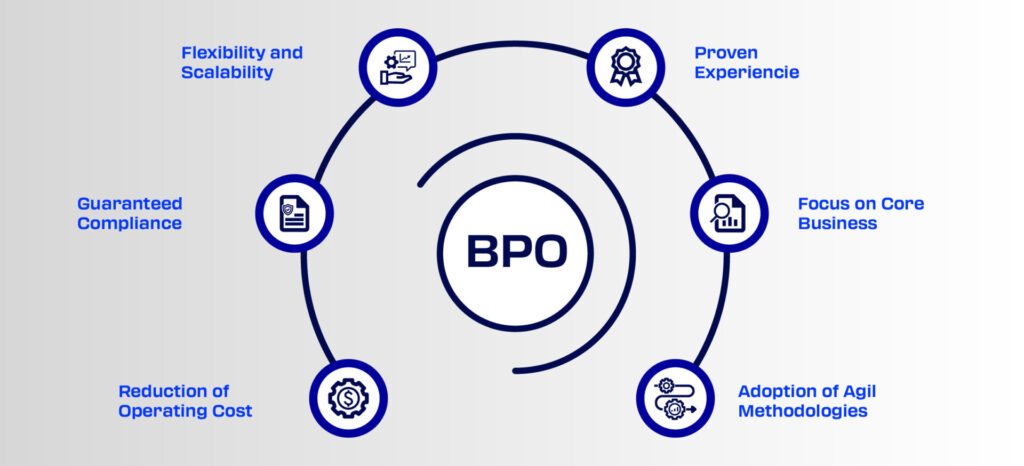Stalled processes, constant rework, and a team drowning in operational tasks that shouldn’t even exist.
While you’re trying to put out fires in PPC, inventory, or logistics, companies are growing without expanding their infrastructure. Do you know why? They use BPO.
But it’s not just any outsourcing you’ve heard of. It’s true BPO, which gets to the heart of your operation, creates order in chaos, takes the burden off your in-house team, and frees your business to grow healthily.
In this article, you’ll understand how BPO can be the game-changer your operation needs and why it’s gone from being a trend to a competitive advantage in the industry.
What is BPO (Business Process Outsourcing)?
BPO, or Business Process Outsourcing, is the practice of transferring operational processes to a specialized team, focusing on efficiency gains, standardization, and performance. But it’s not just about “outsourcing tasks.”
In industrial practice, BPO is a way to professionalize critical activities such as planning, purchasing, PPC, inventory control, logistics, and others.
The big difference lies in the how: with well-defined processes, clear indicators, and experienced teams that work side-by-side with your operations—often even more integrated than internal departments.
BPO doesn’t replace the team; it takes the burden off the routine so the team can focus on what really matters—strategy, continuous improvement, and sustainable growth.

How did BPO emerge?
The concept of BPO emerged in the early 1990s, driven by large multinational companies seeking to reduce costs and increase operational efficiency. At the time, the focus was primarily on administrative areas, such as payroll, customer service, and IT.
Over time, however, the model evolved. It was realized that it wasn’t just about cutting costs—it was about gaining process intelligence. This paved the way for BPO to reach more strategic areas, including within the industrial sector.
Today, BPO is increasingly used by companies looking to improve their operations without increasing internal structure, with greater agility, control, and focus on their core business.
What is the difference between BPO and Outsourcing?
At first glance, they may seem the same: you hand over part of a process to another company and focus on what you do best. But if you think BPO is just about outsourcing operational tasks, you’re leaving value on the table.
Traditional outsourcing typically involves the execution of specific, repetitive activities with low strategic value. These are necessary tasks, but they don’t require analysis, continuous improvement, or business acumen.
Business Process Outsourcing, on the other hand, is a different ballgame. Here, the partner doesn’t just execute: they integrate into your process to optimize, integrate, bring operational intelligence, and accelerate results. The focus isn’t just on reducing costs—it’s on generating efficiency, increasing productivity, and supporting decision-making with reliable data and indicators.
Nelson Simões, Head of BPO, Tech. & Dev. at Vockan, explains that “a good BPO implementation can bring a smaller, yet more capable team with better workflows and tools, promoting significant operational gains (revenue) and lower costs.”
While outsourcing provides labor, BPO delivers process management with measurable performance.
This difference changes everything—especially for those working in complex sectors, such as manufacturing.

Read also: How to Apply Agile Methodologies in Industry and Increase Operational Efficiency
What pain points does BPO solve in the industrial sector?
In industrial routines, the problem isn’t always visible—but the impact is evident in the results. Delays in PPC, excessive rework, imbalanced inventories, and decisions made in the dark are symptoms of an overburdened, poorly integrated operation lacking reliable visibility.
This is precisely where BPO comes in: eliminating the burden of routine operations to make room for strategy.
See some of the main pain points that BPO solves in industry:
Stalled or poorly executed planning
When PPC is constantly chasing losses, BPO provides structure, data analysis, and constant monitoring to ensure predictability.
Rework and communication gaps between departments
By standardizing processes and centralizing execution, BPO reduces friction between departments such as sales, production, purchasing, and logistics.
Wasted time on operational tasks
Does your team spend hours manually entering data, updating spreadsheets, and tracking pending issues? BPO can eliminate this routine and free up your internal team for high-impact decisions.
Lack of visibility and reliable indicators
Without data, industries make decisions based on instinct. BPO ensures management based on reliable, up-to-date, and actionable information.
Difficulty scaling consistently
If each new client or product line creates chaos in the process, BPO organizes the foundation and creates a structure for growth.
Ultimately, BPO solves what seems “normal” in operations—but is actually costing your industry margins, productivity, and growth.
How to implement BPO in your industry: 4 practical steps
Implementing an efficient BPO model isn’t just about hiring an external team. It’s a mindset shift regarding how processes are managed, monitored, and optimized.
Below, we’ll show you a structured path to do this safely and with real impact:
Map current pain points and bottlenecks
First of all, you need to know what needs to be resolved. Which areas are overloaded? Where is there rework, delays, or a lack of visibility?
This diagnosis is essential to define where BPO can generate the most value.
Involve leaders and impacted areas from the beginning. They know the friction points better than any report.
Structure the key performance indicators (KPIs)
BPO is process management — and every process needs to be measured.
Define the KPIs that will be monitored to assess whether BPO is delivering the expected gains: response time, productivity, lead time, number of resolved calls, etc.
Without metrics, there is no improvement.
Align routines, roles, and expectations
The success of BPO depends on clear integration between the internal team and external experts. Establish:
- Who approves what;
- Which channels will be used for communication;
- How deliveries will be monitored.
The fluidity of this relationship ensures that the BPO operates as part of the team—not as a distant support.
Monitor, adjust, and evolve
No model is born 100% ready. Use the first cycles to understand what works, adjust routines, redistribute demands, and explore new profit opportunities.
The ideal BPO grows with you.

Also read: Compliance in Industries: A Complete Guide to Avoiding Risks and Ensuring Safety
Where can BPO be applied?
BPO is an operational strategy to increase predictability and efficiency in critical processes that directly impact production, the supply chain, and customer delivery.
See where it can be applied with the greatest impact:
Production Planning and Control (PPC)
BPO can take over the entire routine of production scheduling, order management, shop floor records, and synchronization between demand and capacity. This prevents bottlenecks and increases on-time delivery rates.
ERP Management
BPO ensures standardization, consistency, and continuous data updates in the ERP system, reducing rework, tax errors, and planning errors.
According to Nelson Simões, “BPO in the context of corporate systems management promotes the capacity to restructure processes that only a dedicated implementation and operational team with years of experience across various verticals and clients can offer. This knowledge is beyond the reach of internal resources, which are essential, but necessarily have their operations and scope dedicated to specific business areas.”
Controlling and Operational Indicators
By outsourcing the consolidation and analysis of industrial data, BPO helps transform scattered information into real-time control panels.
Compliance and Process Monitoring
With specialized teams and robust methodologies, BPO can map critical routines, ensuring adherence to internal standards, certifications (such as ISO), and industry legislation.
Which BPO makes the most sense for your industry?
In industrial practice, there is no single BPO model that fits all. Therefore, Vockan has structured three distinct areas of operation to meet the different realities, maturities, and objectives of companies. Each was designed to deliver the exact level of support your business needs. Check out:
Functional BPO
Ideal for companies that already use Vockan solutions (such as QAD BR+ ERP) and need ongoing support with high adaptability.
Functional BPO acts as a hub for continuous improvement: it meets varied demands, responds to strategic requests, and functions as an extension of your technology and processes team.
It’s the right choice for those seeking a partner who understands the business and delivers agility with technical depth.
Operational BPO
Focused on critical routine activities—especially on the factory floor or specific technical areas. This model employs highly specialized professionals with in-depth knowledge of both industrial processes and the tools applied (such as QAD BR+).
Operational BPO is ideal for when the company needs immediate relief in technical areas with high volume and little room for error.
Agile BPO
Here, the focus isn’t just on execution—it’s on transforming the way your company works. Agilist BPO applies SCRUM-inspired practices to structure routines, increase visibility into deliveries, and improve communication between departments.
It’s an agnostic solution that can be used in any department (IT, supply chain, quality, etc.) and is especially suitable for companies that want greater efficiency and fluidity in their daily operations.
Ready to transform your operational management?
If you’ve made it this far, you already know: BPO is a strategic tool for gaining efficiency, scaling with control, and reducing bottlenecks that hinder your industry’s growth.
Want to understand which model makes the most sense for your scenario?
Talk to a Vockan specialist and discover how to apply BPO in practice, aligned with your reality and your goals.
Optimize processes. Save time. Scale intelligently.











